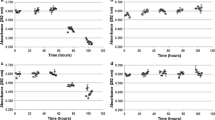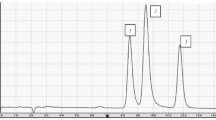Summary
In an exploratory study the 24-h urinary excretion pattern of caffeine and 14 of its major metabolites was studied in 32 volunteers (adults, adolescents and children), 14 patients either with end stage renal disease or liver cirrhosis, 7 heavy smokers and 27 patients on therapy with cimetidine, allopurinol, theophylline or phenytoin. Caffeine and its metabolites were quantified by UV-absorption after liquid/liquid-extraction and HPLC-separation, which ensured proper analysis of 1-methyluric acid.
In adults the renal excretion of caffeine derivatives corresponded to an intake of 509 mg caffeine/day, with 1-methyluric acid as the predominant metabolite. About 69% of caffeine was degraded by the paraxanthine pathway, and theobromine- (19%) and the theophylline pathway (14%) were less important. The ratio of paraxanthine formation to urinary caffeine concentration ( = clearance equivalent) was about 2.2 ml·min−1·kg−1 in adults, and the corresponding ratios for theophylline and theobromine were 0.43 ml·min−1·kg−1 and 0.59 ml·min−1·kg−1, respectively. As expected, caffeine degradation was impaired in patients with cirrhosis and was increased in persons who smoked heavily or who were on phenytoin therapy.
The results document the possibility of noninvasively investigating gross differences in caffeine disposition by analysis of the urinary pattern of its metabolites.
Similar content being viewed by others
References
Conney AH, Pantuck EJ, Kuntzman R, Kappas KE, Anderson KE, Alvares AP (1977) Nutrition and biotransformation in man. Clin Pharmacol Ther 22: 707–720
Vesell ES (1977) Genetic and environmental factors affecting drug disposition in man. Clin Pharmacol Ther 22: 659–679
Caldwell J (1985) Glucuronic acid conjugation in the context of the metabolic conjugation of xenobiotics. In: Matern S, Bock KW, Gerok W (eds) Advances in glucuronide formation. MTP Press, Lancaster Boston The Hague, pp 7–20
Bircher J (1983) Quantitative assessment of deranged hepatic function: a missed opportunity. Semin Liver Dis 3: 275–284
Bock KW, Wiltfang J, Blume R, Ullrich D, Bircher J (1987) Paracetamol as test drug to determine glucuronide formation in man. Effects of inducers and smoking. Eur J Clin Pharmacol 31: 677–683
Ashton CH (1987) Caffeine and health. Br Med J 295: 1293–1294
Barone JJ, Roberts H (1984) Human consumption of caffeine. In: Dews PB (ed) Caffeine: perspectives from recent research. Springer, Berlin Heidelberg New York, pp 59–73
Arnaud MJ (1984) Products of metabolism of caffeine. In: Dews PB (ed) Caffeine: perspectives from recent research. Springer, Berlin, Heidelberg New York, pp 3–38
Grant DM, Tang BK, Kalow W (1983) Variability in caffeine metabolism. Clin Pharmacol Ther 33: 591–602
Blanchard J, Sawers SJA (1983) The renal clearance of caffeine in man. Eur J Clin Pharmacol 24: 93–98
Tarka SM, Arnaud MJ, Dvorchik BH, Vesell ES (1983) Theobromine kinetics and disposition. Clin Pharmacol Ther 34: 594–555
Birkett DJ, Dahlqvist R, Miners JO, Lelo A, Billing B (1985) Comparison of theophyline and theobromine metabolism in man. Drug Metab Dispos 13: 725–728
Blanchard J, Sawers SJA, Jonkman JHG, Tang-Liu DD (1985) Comparison of the urinary metabolite profile of caffeine in young and elderly males. Br J Clin Pharmacol 19: 225–232
Lelo A, Miners JO, Robson R, Birkett DJ (1986) Assessment of caffeine exposure: caffeine content of beverages, caffeine intake, and plasma concentrations of methylxanthines. Clin Pharmacol Ther 30: 54–59
Burg AW (1975) How much caffeine is in the cup. Tea Coffee Trade J 147: 40–42
Gilbert RM, Marshman JA, Schwieder M, Berg R (1976) Caffeine content of beverages as consumed. Can Med Assoc J 114: 205–208
Price Evans DA, Mahgoub A, Sloan TP, Idle JR, Smith RL (1980) A family and population study of genetic polymorphism of debrisoquine oxidation in the white British populations. J Med Genet 17: 102–105
Meier PJ, Mueller HK, Dick B, Meyer UA (1983) Hepatic monooxygenase activities in subjects with a genetic defect in drug oxidation. Gastroenterology 85: 682–692
Miotti T, Bircher J, Preisig R (1988) The 30-minute aminopyrine breath test: optimization of sampling times after intravenous administration of14C-aminopyrine. Digestion 39: 241–250
Trang JM, Blanchard J, Conrad KA, Harrison GG (1985) Relationship between total body clearance of caffeine and urin flow in elderly men. Biopharm Drug Dispos 6: 51–56
Sachs A (1984) Angewandte Statistik, 6te Aufl. Springer, Berlin Heidelberg New York
Lindsey AS, Sharman RK (1981) Some observations on the stability of uric acid in alkaline solutions. Anal Lett 14: 799–811
Löffler W, Gröbner W, Medina R, Zöllner N (1982) Influence of dietary purines on pool size, turnover, and excretion of uric acid balance conditions. Res Exp Med 181: 113–123
McNabb RA, McNabb FMA (1980) Physiological chemistry of uric acid: solubility colloid and ion-binding properties. Comp Biochem Pharmacol 67: 27–34
Scott NR, Chakraborty J, Marks V (1986) Urinary metabolites of caffeine in pregnant woman. Br J Clin Pharmacol 22: 475–478
Callahan MM, Robertson RS, Branfman AR, McComish MF, Yesair DW (1983) Comparison of caffeine metabolism in three nonsmoking populations after oral administration of radiolabeled caffeine. Drug Metab Dispos 11: 211–217
Bonati M, Latini R, Galletti F, Young JF, Tognoni G, Garattini S (1982) Caffeine disposition after oral doses. Clin Pharmacol Ther 32: 98–106
Morgan KJ, Stultes VJ, Zabrik ME (1982) Amount and dietary sources of caffeine and saccharine intake by individuals ages 5 to 18 years. Regul Toxicol Pharmacol 2: 296–307
Albeit ML, Niklas TA, Frank GC, Webber LS, MH Miners, Berenson GS (1988) Caffeine intakes of children from a biracial population: the Bogalusa heart study. J Am Diet Assoc 88: 466–471
Zoumas BL, Kreiser WR, Martin RA (1980) Theobromine and caffeine content of chocolate products. J Food Sci 45: 314–315
Lelo A, Miners JO, Robson RA, Birkett DJ (1986) Quantitative assessment of caffeine partial clearances in man. Br J Clin Pharmacol 22: 183–186
Tang-Liu DD, Williams RL, Riegelman S (1983) Disposition of caffeine and its metabolites in man. J Pharmacol Exp Ther 224: 180–185
Grant DM, Tang BK, Kalow W (1984) A simple test for acetylator phenotype using caffeine. Br J Clin Pharmacol 17: 459–464
Lelo A, Miners JO, Robson RA, Birkett DJ (1986) Comparative pharmacokinetics of caffeine and its primary demethylated metabolites paraxanthine, theobromine and theophylline in man. Br J Clin Pharmacol 22: 177–182
Jost G, Wahlländer A, Mandach U v., Preisig R (1987) Overnight salivary caffeine clearance: a liver function test suitable for routine use. Hepatology 7: 338–344
Pisi E, Checchia GA, Bianchi GP, Fabbri A, Zoli M, Marchesini G (1988) Measurement of liver function using caffeine as the test compound. Comparison between standard clearance technique and one-sample simplified procedure. In: Gentilini P, Dianzani MU (eds) Pathophysiology of the liver. Elsevier, pp 165–170
Miners JO, Attwood J, Wing LMH, Birkett DJ (1985) Influence of cimetidine, sulfinpyrazone, and cigarette smoking on theobromine metabolism in man. Drug Metab Dispos 11: 598–601
Grygiel JJ, Miners JO, Drew R, Birkett DJ (1984) Differential effects of cimetidine on theophylline metabolic pathways. Eur J Clin Pharmacol 26: 335–340
Grant DM, Tang BK, Campbell ME, Kalow W (1986) Effect of allopurinol on caffeine disposition in man. Br J Clin Pharmacol 21: 454–458
Broughton LJ, Rogers HJ (1981) Decreased systemic clearance of caffeine due to cimetidine. Br J Clin Pharmacol 12: 98–106
Wietholtz H, Voegelin M, Arnaud MJ, Bircher J, Preisig R (1981) Assessment of the cytochrome P-448 dependant liver enzyme system by a caffeine breath test. Eur J Clin Pharmacol 21: 53–59
Parson WD, Neims AH (1978) Effect of smoking on caffeine clearance. Clin Pharmacol Ther 24: 40–45
Campbell ME, Spielberg StP, Kalow W (1987) A urinary metabolite ratio that reflects systemic caffeine clearance. Clin Pharmacol Ther 42: 157–165
Lambert GH, Schoeller DA, Kotake AN, Flores C, Hay D (1986) The effect of age, gender, and sexual maturation on the caffeine breath test. Dev Pharmacol Ther 9: 375–388
Tang-Liu DD, Williams RL, Riegelman S (1982) Nonlinear theophylline elimination. Clin Pharmacol Ther 31: 358–369
Gundert-Remy U, Hildebrandt R, Hengen N, Weber E (1983) Non-linear elimination process of theophylline. Eur J Clin Pharmacol 24: 71–78
Walther H, Banditt P, Köhler E (1983) Aussagefähigkeit von Coffeinwerten in Serum, Speichel und Urin — Ermittlung von pharmkokinetischen Daten durch non-invasive Methoden bei psychopharmakologischen Untersuchungen. Pharmacopsychiat 16: 166–170
Jenne JW, Nagasawa HT, Thompson RD (1976) Relationship of urinary metabolites of theophylline to serum theophylline levels. Clin Pharmacol Ther 19: 375–381
Loughnan PM, Sitar DS, Ogilvie RI, Eisen A, Fox Z, Neims AH (1976) Pharmacokinetic analyis of the disposition of intravenous theophylline in young children. J Pediatr 88: 874–879
Aranda J, Collinge J, Zinman R, Watters G (1979) Maturation of caffeine elimination in infancy. Arch Dis Child 54: 946–949
Author information
Authors and Affiliations
Rights and permissions
About this article
Cite this article
Ullrich, D., Compagnone, D., Münch, B. et al. Urinary caffeine metabolites in man. Eur J Clin Pharmacol 43, 167–172 (1992). https://doi.org/10.1007/BF01740665
Received:
Accepted:
Issue Date:
DOI: https://doi.org/10.1007/BF01740665




